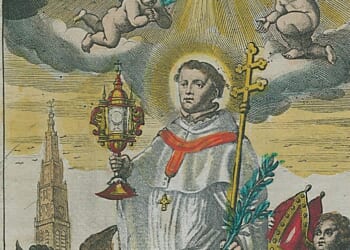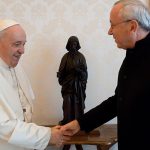When the French Cardinal stood on the loggia over St. Peter’s Square and the name “Leo XIV” was announced, the Church and the world learned something unprecedented: the successor of Peter hailed from Chicago. In choosing the name Leo—rich with historical resonance—and bringing with him the formation of a distinctly American, urban, and immigrant-rooted Catholicism, this new pope represents more than just a geographical novelty. He embodies a new kind of global Church, one shaped as much by the neighborhoods of Midwestern America as by the hills of Rome.
This moment offers not just an opportunity to celebrate a native son of the United States ascending to the papacy. It invites us to ask: what does it mean—for the Church and the world—to have a pope whose upbringing formed him with the unique spiritual and social climate of Chicago?
This isn’t an attempt to forecast policies or assign identity politics to the papacy. But place matters. Geography leaves fingerprints on vocation. And to understand where Pope Leo XIV comes from is to gain insight into the Catholic imagination that formed him.
The City as Catechist
Chicago is, above all, a city of neighborhoods—dense with identity, conflict, creativity, and faith. It has long been a living catechism of American Catholic life: Irish parishes with weather-worn statues of St. Patrick, Polish churches with ceilings of gold leaf, Mexican processions winding through working-class streets on the feast of Our Lady of Guadalupe. It is the city of Cardinal Bernardin and the “seamless garment”; of parish basketball and social justice; of union halls and perpetual adoration chapels.
For over a century, Chicago has been a proving ground for American Catholicism’s dual identity—as both deeply rooted in tradition and vigorously engaged with the world around it. Its parishes have been places of refuge, resistance, and renewal. They’ve produced priests and poets, nuns and neighborhood organizers, all wrestling with what it means to live faithfully in a pluralistic, competitive, often inequitable society.
It is not hard to imagine how a pope formed in such a place might bring with him a theology with sidewalks—a Church not afraid of the modern city, but baptized into it.
Immigrant Catholicism: A Spiritual Heritage
Like most of America, Chicago’s Catholic culture was built by immigrants: Irish fleeing famine, Italians escaping poverty, Poles and Slovaks resisting political oppression. These communities brought with them not only their languages and cuisines, but their saints, devotions, and a fierce sense of identity. They built towering Gothic churches and humble parish schools, often stone by stone, paycheck by paycheck.
In time, these communities gave way to new waves of immigrants—Mexicans, Filipinos, Vietnamese, Central Americans—each adding new vitality and urgency to the Church’s mission.
If Leo XIV’s papal vision is informed by the legacy of Leo XIII, who wrote boldly on labor, immigration, and the dignity of the working poor, it is no stretch to imagine that those ideas took on flesh in the city streets and parish basements of Chicago. The social encyclicals weren’t just read there—they were lived.
And so, the election of a pope from Chicago isn’t just about the United States. It’s about the global Catholic experience refracted through a quintessentially American lens: one of movement, struggle, diversity, and resilience.
A City That Demands Dialogue
The Catholic Church in the United States is often painted in polarized hues: liberal and conservative, traditional and progressive, pre- and post-conciliar. But in Chicago, that binary seldom holds. The same parish might house a charismatic prayer group, a Spanish-language Mass, and a Rite of Christian Initiation for Adults class taught by a retired Jesuit—all within the same week.
Catholics in Chicago have long had to live with difference—ethnic, economic, political, theological. It’s a Church where dialogue is not a luxury, but a necessity. This capacity for dialogue—deep, difficult, patient—may be one of Pope Leo XIV’s greatest assets. In a global Church increasingly fractured by ideology and shaken by scandal, we may need a pope formed not only by doctrine but by communion amid complexity.
And where better to have learned that than in a city where Catholicism is not a monolith, but a mosaic?
The American Experience—Without American Exceptionalism
There’s a temptation, of course, to read Leo XIV’s election as a kind of national triumph: the first American pope! But the reality is subtler, and more beautiful. His papacy is not about America leading the Church—only a fool would pretend that this is the case. Rather, it’s a moment in which the Church acknowledges that the American experience, with all its tensions and aspirations, now fully belongs to the global Catholic story.
The American Church has often wrestled with its identity—at times insecure about its youth and pluralism, at other times overly confident in its resources and influence. But Leo XIV’s background offers an integrated model: an American Catholicism that is faithful without being defensive, confident without being triumphalist.
His election doesn’t announce American dominance. It invites American responsibility—a call to model what Catholicism can look like when it is neither state-sponsored nor underground, neither homogeneous nor atomized. A Catholicism with room for both catechesis and controversy, both Eucharistic processions and public advocacy.
The City on a Hill—and in the Streets
There’s an old American image, drawn from Scripture, of being a “city on a hill”—a beacon, a moral compass. But Pope Leo XIV comes not from the hill, but from the streets: places marked by potholes and poetry, by segregation and solidarity. His is not a distant, idealized vision, but one drawn from the real-world lives of families, workers, refugees, and dreamers.
That may be a gift for the whole Church. As Catholicism becomes increasingly urban, migratory, and complex, the Church needs a pope who understands not just the grand basilicas, but the sound of sirens and the smell of tamales at parish festivals. A pope who has seen the beauty of Catholic life not only in doctrine, but in the everyday drama of faith lived out in neighborhoods.
His Chicago roots don’t define his papacy, but they flavor it. They give us a glimpse into a Church that is alive in cities, animated by immigrants, and comfortable with both complexity and conviction.
In this sense, the new pope’s hometown is not just a point on a map—it’s a point of departure. From the neighborhoods of Chicago to the chair of Peter, Pope Leo XIV carries with him the prayers, struggles, and hopes of a Church on the move.
Photo from Vatican Media
















